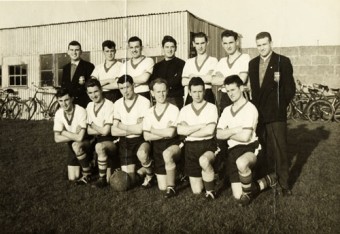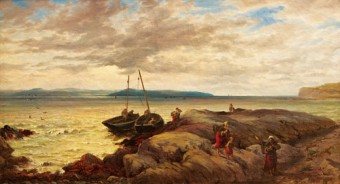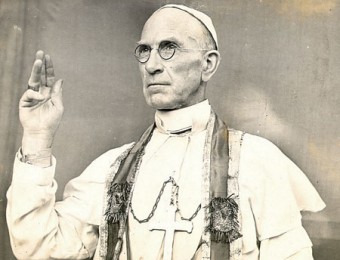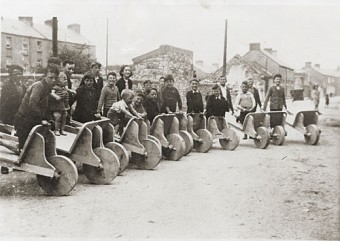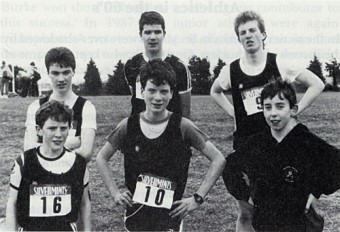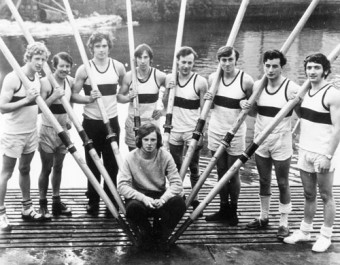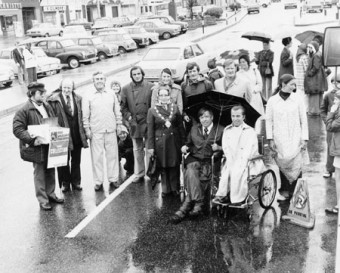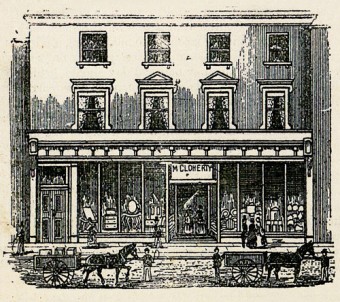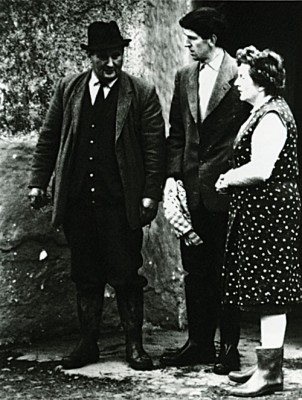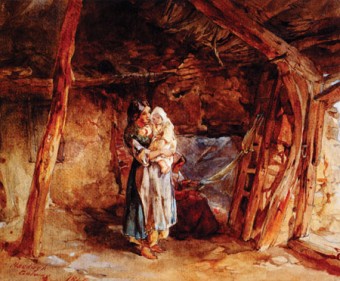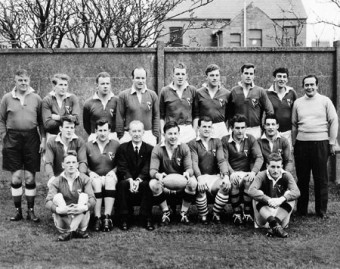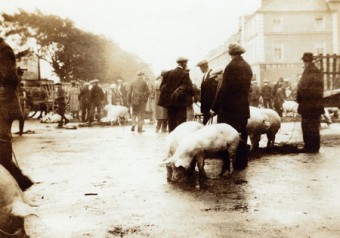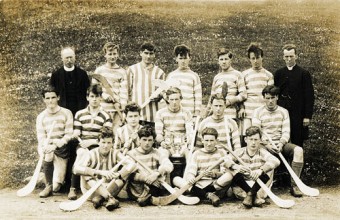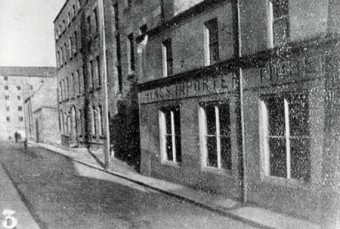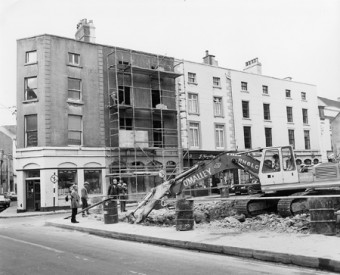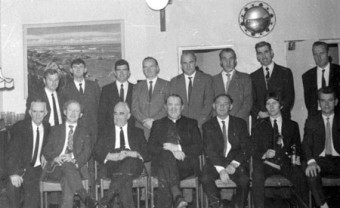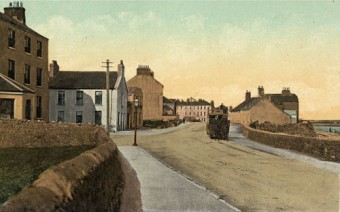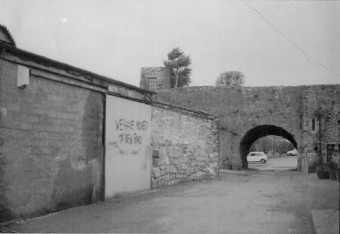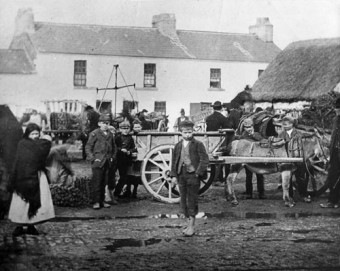Our Lady’s Boys Club
Thu, May 31, 2012
Our photograph today is of a 1950s soccer team representing Our Lady’s Boys Club, taken in Terryland where facilities were quite primitive at the time and, as you can see, the preferred mode of transport apart from shank’s mare was cycling. The team is, back row, left to right: Patsy Burke, Richie O’Connor, Brod Long, Brendan Dowling, Paddy Power, Tommy Carr, Paddy Beatty. In front are Danny Collins, Billy Carr, John Rushe, Steve Mannion, Gus O’Connor, and Barney Birkett.
Read more ...Landing fish at Blackrock
Thu, May 17, 2012
Our image today is of a painting entitled Morning – Landing Fish at Blackrock, Galway Bay by an English painter named Thomas Rose Miles dated c1895. There is probably a little artistic licence taken but it is a fascinating study of the bay which is very difficult to capture in paint. There is just a thin strip of land visible on the far side, nothing very dramatic, and of course the light and colours change constantly. The sunlit area we see on the Clare coast corresponds to Ballyvaughan and the landmass to the west of that has been darkened for artistic effect. Though they are probably not visible in this reproduction, there are a lot of fishing boats on the bay.
Read more ...Eugene Daly, survivor of the Titanic
Thu, Apr 12, 2012
Eugene Daly was a 29-year-old weaver in Athlone Woollen Mills who decided to leave his job and go to America. He paid £6-19 for a third class ticket and boarded the Titanic at Queenstown. He was a piper and played native airs on board the tender on the way out to the liner. One of the survivors later sourly noted, “Looking astern from the boat deck, I often noticed how the third-class passengers were enjoying every minute of the time, a most uproarious skipping game of the mixed double was the great favourite whilst “in and out and roundabout” went a man with his bagpipes playing something that ‘faintly’ resembled an air.”
Read more ...Old Sickeen
Thu, Mar 22, 2012
This photograph was taken in the early 1940s and shows a happy group of children in Sickeen. The wall at their backs was the boundary wall of St Brendan’s National School. In the background on the left are the backs of houses which fronted on to St Brendan’s Road. They were occupied by the Lillis family, the Lohan family, the Molloys – home of ‘Five Goal Molloy’ aka Sonny, Maurice O’Connell who worked in the post office, Jim Redington who later became Mayor of Galway, and Tom Walsh who was a teacher in St Brendan’s School.
Read more ...Athletics in St Mary’s College
Thu, Mar 08, 2012
St Mary’s opened in 1912 with 60 boarders and 17 day boys. The first school sports there took place in 1928, and since then the college has produced many fine athletes in track and field. The first mention of All-Ireland sports in the annals of the school concerns Tom Fahy, who in 1938 set a new Irish record for the 12lb shot. In 1939 the school won its first Connacht Schools title; in 1943, it won three titles, four in 1946, and five in 1947. In that last year, one athlete, Martin Kilmartin, won three golds, and set records in both the triple jump and the long jump. In 1948 the college again won five titles, and in 1950 John Linnane set a new Irish record in the pole vault.
Read more ...Rowing on the Corrib
Thu, Mar 01, 2012
Rowing ‘matches’ or ‘badge races’ have been taking place on the river for at least 150 years. Initially, they were confined to members of Corrib Rowing and Yachting Club, as it was the only boating club in existence here. When the Commercial Club was formed in 1875, a meeting was held to promote a regatta on the stretch of river under Menlo Castle. It was well attended, and there was general agreement that the regatta should be independent of both clubs, and open to everybody.
Read more ...The Galway Lions Club, a brief history
Thu, Feb 23, 2012
Lions International is a worldwide organisation with more than one million members, united in their aims under the motto “We serve”. The Galway Lions Club was formed 40 years ago, and since then has been a very active group in helping the less fortunate members of our community. Essentially, what members do is very good work, and they enjoy doing it, but none of it would have been possible without the remarkably generous support of the general public.
Read more ...Michael Cloherty’s new premises, 36 Shop Street, 1902
Thu, Feb 09, 2012
“Opening of New premises. Michael Cloherty, ironmonger and seedsman begs to inform his numerous customers and the public in general, that owing to his premises in Williamsgate Street having been burnt down, and being desirous of meeting the requirements of his Patrons, he has purchased the extensive premises owned by his brother, Mr Henry Cloherty, and known as 36, Shop Street, Galway, which he has stocked with an extensive Supply of all descriptions of Goods suitable to his Trade, so that those who patronised him in the past may not suffer any inconvenience in obtaining whatever class of goods they may require, in keeping with the business carried on in his late establishment.
Read more ...People that my family knew...
Thu, Feb 09, 2012
My grandmother was born in Moylough, Co Galway, in 1890, and when I knew her she projected an image of Irish Catholic propriety. She went to daily Mass, and stopped to say the Angelus at noon and 6pm. She was generous with the price of a jacket or a ‘smart’ pair of shoes if she felt that I looked a bit shabby. She’d make my mother jealous by making the best chocolate cake ever!
Read more ...Cottage interior in the Claddagh, 1844
Thu, Feb 02, 2012
This illustration is of an original pencil and watercolour painting by Francis Topham which now hangs in the Ulster Museum. It was painted in 1844, just before the Famine, and shows the interior of a cottage in the Claddagh.
Read more ...Heroes in green jerseys
Thu, Jan 26, 2012
The extraordinary heroics and the wonderful result in the Sportsground on Friday last unleashed joy unconfined and gave all Connacht rugby supporters a great lift. As Eric Elwood rightly said, “The players and the crowd got their just reward,” so we thought to honour the occasion by showing you the Connacht team that travelled to Ravenhill on November 19, 1958, and beat Ulster.
Read more ...Running a city on village lines
Thu, Jan 12, 2012
This photograph of a pig fair was taken about 100 years ago on a wet day at the top of Eyre Square. The corner we see on the right was occupied by Michael Walsh, family grocer, wine and spirit merchant, who claimed to have the most superior quality of goods always kept in stock... “A trial will convince”. In the foreground are a typical group of farmers who have travelled into town with their tall carts carrying their pigs. They have them on show with a rope tied around each animal’s leg to avoid them running all over the place. You can almost sense these farmers praying for a buyer to come along, because if they did not sell they would have to bring their pigs home again. Not all farmers had the luxury of carts, and those who walked their animals into town and did not sell, would have to walk them home again.
Read more ...St Mary’s College, almost one hundred years old
Thu, Dec 29, 2011
Our photograph today shows the St Mary’s College hurling team which won the competition played between their school, Garbally, and St Flannan’s in 1924. The diocesan magazine The Mantle published this image and provided an update on the players in 1959, so the notes after their names describe their status in 1959.
Read more ...The Vincent de Paul Society, Galway’s oldest charity?
Thu, Dec 08, 2011
Today’s photograph was taken about 100 years ago and shows part of St Augustine Street. In the foreground is Hynes’ retail shop. Hynes’ were major importers and had a yard and warehouse on the docks, so they could unload imported cargo directly from the ship across the street into the yard. The shop sold all kinds of hardware and builder’s materials. The shop has gone now and is replaced by what is known as the Hynes Building which houses the County Library and various offices.
Read more ...From drab facades to the Latin Quarter
Thu, Dec 01, 2011
This photograph was taken only 25 years ago, but it shows how much Galway has changed in that space of time, and particularly the area of High Street, Quay Street, and Cross Street.
Read more ...When Michael D was vice president
Thu, Nov 24, 2011
For some reason the game of soccer seemed to be popular with Claddagh people. In the 1930s there were at least three teams representing the area. Claddagh Rangers were playing senior soccer, the equivalent of League of Ireland today, Old Claddonians were fielding teams, and by 1937, Galway Rovers were developing a youth team as well as a junior side. In their early days Rovers had no clubhouse, though the Old Malt pub could be described as a hangout, as could the Atlanta Hotel, whose owner Josie Owens had strong connections with the club.
Read more ...The end of the tramline
Thu, Nov 17, 2011
This photograph of the sleepy village of Salthill was taken about 100 years ago. In the mid nineteenth century, the village was very small and occupied mostly by fishermen, some lodging houses and a few pubs. The area was much changed and improved by the building of the Eglinton Hotel in the mid 1860’s. This up-market establishment was on a much grander scale than any other building in the vicinity, and it attracted a different kind of tourist. It is on the left of our picture, with the small bar in front.
Read more ...The back of the arch
Thu, Nov 10, 2011
The buildings we see on the left of our photograph were once two-storey houses which featured on the 1651 map of Galway. Some years ago, in this column, we showed a painting of those houses and also the ones across the street which gave the impression of a continental atmosphere to this area. According to Griffith’s Valuation, which was published c1855, the houses on the left were occupied at that time by Dennis Quinn, Patrick Commons, and Michael Derrane, all of whom kept lodgers.
Read more ...The potato market at the Small Crane
Thu, Nov 03, 2011
This remarkable photograph of the Small Crane (Where was the Big Crane?) was taken about 1890 with the potato market in full swing. This market was held here regularly, and was an occasion where town met country. Farmers from as far west as Inverin would bring their potatoes into town to sell to shopkeepers and individuals. The scale, which was kept steady by large rocks, was used to weigh the sacks. You can see potatoes stacked loosely on the ground beside the creels.
Read more ...
